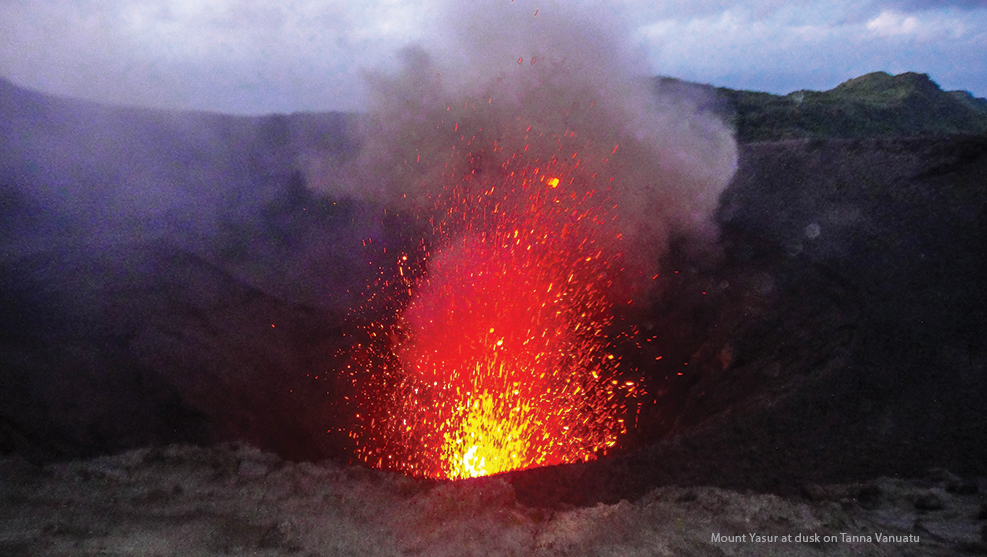Tanna, Vanuatu offers a land of natural wonder and hospitable people (published September 2013)
Active volcanoes, dense forests, pristine bays, rugged mountains, cyclones, earthquakes, ash plains, bamboo huts, chiefs, pigs, kava, cannibalism, cargo cults and malaria. It feels as though we’ve sailed back in time to arrive when the Earth was young and volatile with indigenous tribes living in small villages tucked deep in the bush.
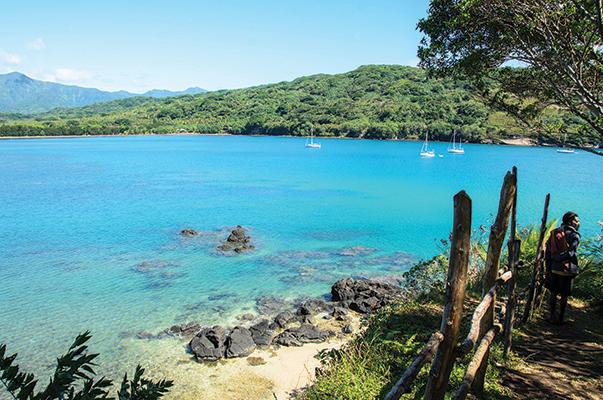
Under a brilliant blue sky Tenaya inched her way into Port Resolution, the safest anchorage at Tanna, Vanuatu. Shallow and poorly charted with bits of reef and coral scattered about, it is open from east to north and exposed to an easterly swell. Some are doubtful of this dastardly destination but we were delighted to be here. Tanna is one of our favorite places on Earth and with a stern anchor set into the swell we went ashore to explore. Some places are all about the water. Tanna is all about the adventures on land.
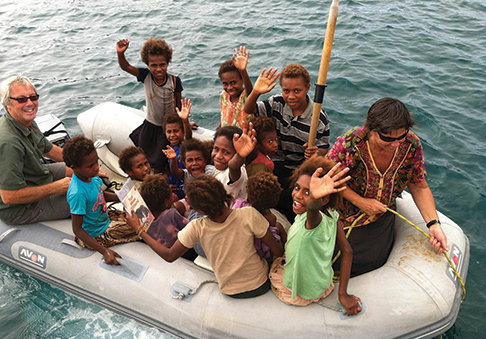
Jim drinking kava prepared especially for us
LAND AND PEOPLE
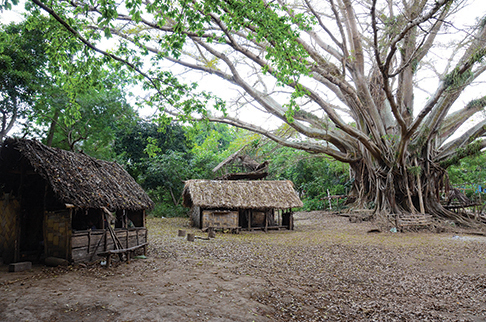
People in Tanna live much as they have for centuries in houses made of bamboo and pandanus topped with the woven leaves of coconut trees and earthen floors. Each person has a garden and every family has chickens and pigs. People eat what they raise or hunt. Women wash laundry in hot water provided by the volcano. Men fish with nets, lines or spears from their hand hewn dugout canoes. And the irony of them paddling up to Tenaya asking to have their mobile phones charged brought us back to the 21st century.
Mount Yasur, an active Strombolian volcano, rises just beyond the northern portion of the anchorage. During the day, clouds of ash drift from the summit and eruptions paint the sky a reddish hue at night. Steam rises from fumeroles on the steep green hillside and boiling pools at the water’s edge attest to more emissions from the spry old guy. He has been active for 800 years.
One truly amazing evening began with a truck ride to within 150 yards of the rim of the volcano, a rim devoid of any man-made objects—no path, railing or lights. Should one misjudge a step in the black of night, stumble over a previously expelled pyroclastic bomb and slide down into the fiery cauldron, well, consider the gene pool cleansed of a little clumsiness.
Yasur rumbles constantly but when he begins to roar, look out. Or rather, up. A concussion wave of gas precludes a huge dark cloud of ash boiling up from the bowels of the earth, which gives way to incandescent lava and burning projectiles exploding ferociously skyward. Indeed, Mount Yasur, the belching behemoth banishing billions of bits of blazing bullets, is the main reason most people visit Tanna.
EMBRACING THE EXPERIENCE
My right quad threatened to cramp as I kept pressure on the bent leg to force my upper body away from the person next to me. My head bobbed and occasionally bounced off the window to my left. Our shoulders banged together and the angle of the slippery seat encouraged my body to overtake his. Fortunately, the guy next to me was my husband, Jim.
The small 4WD pick-up truck in which we were wedged was simply driving down the road. But on Tanna, the word “road” is used very loosely. I have yet to see pavement. The island is mountainous and Mother Nature is not always kind. Cyclones rip through, seasonal rains deluge, sudden earthquakes shift the land and the active volcano spews prodigious amounts of fine ash. None of which are conducive to maintaining roads.
We bucked along under a canopy of thick bush, across an arid ash plain, up dry riverbeds, over outcroppings of lava and through deeply gouged ruts. The truck bottomed out, scraped its fenders and was brushed by low-hanging branches but continued to plod along slowly, methodically, uncomfortably.
It’s a wonder none of the 16 people crammed in the back fell out. They looked as if they were barely hanging on, as if this were all a completely normal trip to the market. For them it was. I was happy we had scored seats inside the cab for the trip across the island to Lenakel where customs, Internet and a bank awaited.
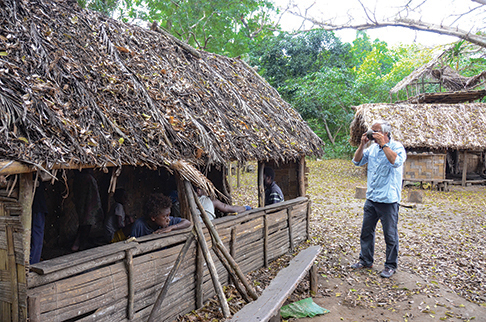
We found our local friend, Winnie, at the market where women of her village sell gorgeous woven baskets and she invited us to her home high in the hills. “Do you want some kava?” she asked “Sure,” Jim and I answered. I was handed half a coconut shell filled nearly to the brim with muddy colored, mildly intoxicating, entirely foul tasting liquid. Down it went in one gulp. For some reason I was pleased. Next it was Jim’s turn. Our lips tingled and our minds floated in contentment.
Jim was in a position to watch the kava being prepared. I am truly happy I was not. In the nakamal under the shade of a giant banyan tree, two young boys chewed the root and spit it onto a dirty t-shirt. One man poured water on it while another wrung it over a coconut cup. This village has no water—no streams, springs, pipes or tanks. All water is brought to the village in reused jugs by pick-up trucks. Where the water for the kava came from, or how long it had been sitting uncovered, were details we were happier not knowing. We would be quite surprised if these cups, which had undoubtedly passed the lips of most of the village men, had ever been cleaned.

RITE OF PASSAGE
Between the ages of five and 10, a boy is taken from the village to a secret spot deep in the bush for up to three months. Women are not permitted to see him. There, the eldest son of the chief performs a circumcision and the boy is given a calming drink but no local anesthetic to ease the pain. During his recovery the boy is cared for by a medicine man and a special teacher passes important information about his culture to him. Nothing is written; all is remembered.
He bathes twice a day at a nearby lake when a shell is blown to clear the road of any women. The details vary from village to village but the process remains largely the same for kastom (traditional) followers. Once the wound heals there is a great circumcision ceremony where the boy is reintroduced as a man and the chief announces his ranking in the village. This ceremony happens only once a year so there are often multiple boys. We were fortunate enough to be invited to attend.
Headdresses of glittering garland, face paint, colorful grass skirts and brilliantly dyed feathers wrapped the women like magnificent gifts. Vibrant traditional lava lavas covered the men’s shorts while many wore a narrow wreath of natural fibers around their head into which a multicolored feather was precariously placed. In a blazing display of traditional costumes, the villagers radiated custom and culture. Jim and I were dressed up traditionally and our faces painted. Big smiles and hearty laughter, not at all malicious, welcomed us. Despite Winnie’s efforts, I’m fairly certain we did not completely blend in.
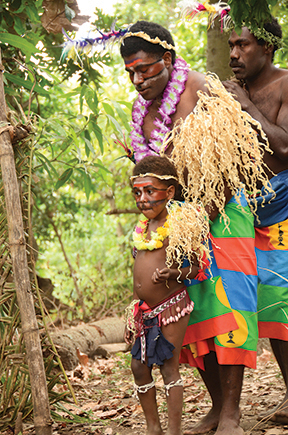
An enormous mound of gifts was built by carefully layering yams and taro, packages of laplap, colorful fabric and intricately woven mats, all topped with a bundle of baskets. Massive kava roots, several pigs and a cow were hauled out before all the men drifted off. But an air of excitement grew among the women and small children. The long, low sound of a conch shell being blown resonated through the trees. A hush fell over the clearing. Slowly men filed out in a single line very solemnly. Each carried an offering decorated with red and yellow leaves. A small boy was the only person not wearing a lava lava wrapped around his waist. Dried grass bands encircled his legs and head. An elaborate belt with dangling shells held up his newly trimmed, much over-wrapped penis. Streamers flowed from the end. A nice touch, we thought.
The boy’s maternal grandfather found his way to the center as all the men formed a circle. They stomped and chanted while women jumped up and down around the perimeter. Wielding a can in each hand, he doused everyone with air freshener as he swayed to the music with a euphoric grin on his face. When the dancing finished, the men of his village returned to the pile and carried things off. Soon it was completely dismantled and time for a rest. After dark the dancing continued. Men chanted and stomped as the women skipped around them in a furious whirl of color. As I approached for a closer look a leaping woman clasped my hand and hauled me into their orbit and spun me back in time.
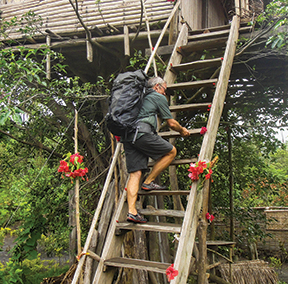
A DEEPER UNDERSTANDING
Our new friend Kelson then guided us on a two-hour walk from Port Resolution to the traditional village of Ikquramanu. A narrow track past a pretty garden led us to a house perched high in a banyan tree. The railing, which only existed on one side, was decorated with clusters of hibiscus. This would be our accommodation for the next two nights.
Because we lead such a nomadic lifestyle, Jim and I never feel as though we are on vacation. Each day is an adventure and Tenaya is our home, wherever she happens to be. Some days are more exciting than others and this was turning out to be an exceptional one.
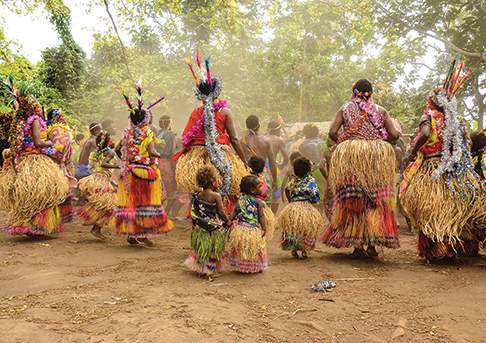
We could have listened to Joseph, the chief’s first born son, explain the use of certain plants as medicinal remedies for hours but a chorus in the distance signaled it was time for us to watch Napen Napen. In a clearing under an impressive banyan, women of all ages dressed in long, colorful grass skirts and painted faces appeared singing and dancing. It was fascinating and we watched intently, amazed that cultures like this still exist in the world.
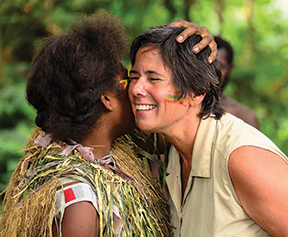
While the women lingered after they’d finished, I hopped up and did a little dance of my own clicking my heels together. Their eyes widened as they roared with laughter. Someone wrapped a skirt around my waist, painted my face and they taught me to dance properly.
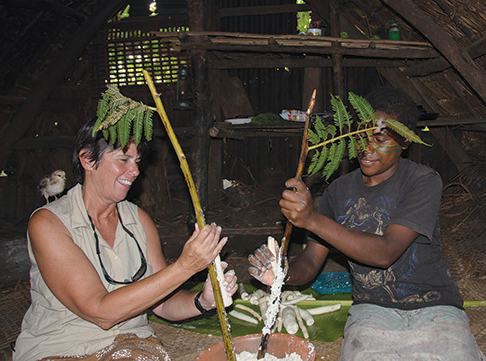
Late that afternoon while Jim drank kava with the men, I helped our hosts Alice and Joanne prepare dinner in the cooking hut. My job was to help grate manioc for the laplap. Sitting on a mat covering the dirt floor, we rubbed the tubers on the pointed welts of black palm branches. No metal gadgets for these women.
Joanne kneaded the manioc while Alice and I squeezed handfuls of coconut shreds soaked in coconut water over large banana leaves. Next the glutinous manioc was plopped onto the leaves and smoothed to an even thickness before a final squeeze of coconut milk. The leaves were folded over and the package tied with long, sinewy fibers. Joanne carried it outside, placed it on the fire and covered it with layers of hot stones and dirt to bake.
When the men returned, Jim and I were served the laplap. Chief Kazimak joined us while everyone else looked on. After dinner, Kelson offered to translate for the chief if we had any questions. Eventually, the subject turned to cannibalism. Chief Kamisak said that land has always been very important to the people of Vanuatu. It is passed from father to son. Should someone trespass on another’s land, it was perceived as aggressive behavior and the man must be killed.
“Killed, yes, but why eaten?” we asked. He gave a shrug of the shoulders and a look as if to say, “it is dead, it is meat … what else would you do with it?” Simple answer, really. When asked if men were eaten for a specific reason such as to attain strength or power, Kelson and the chief conferred a moment before answering, “No, they just ate them.” We are pleased that people of Vanuatu no longer consider cannibalism a viable deterrent to curious travelers. Today they are incredibly kind and the most hospitable people we have met in our travels.
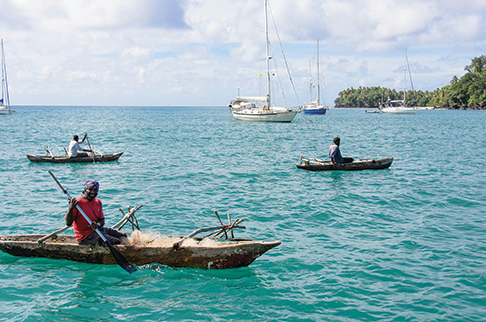
Tanna is a wonderful stop along the coconut milk run that offers voyagers a unique opportunity to connect with people who live simply and without the conveniences we cherish. Our visit was a wonderful eye-opening experience from which we emerged wondering who really is the richest. But then again, some anchorages are all about the water.
Katie and Jim Thomsen sailed from the North Sea, down the Atlantic coast, into the Med and across the Atlantic aboard their 40-foot Hallberg-Rassy. After sailing up and down the Eastern Caribbean they crossed through Panama and into the Pacific. Six years and 30,000 miles later, Katie continues to improve her sailing skills by venturing into higher latitudes while delving deeply into the lands and cultures she encounters.

















